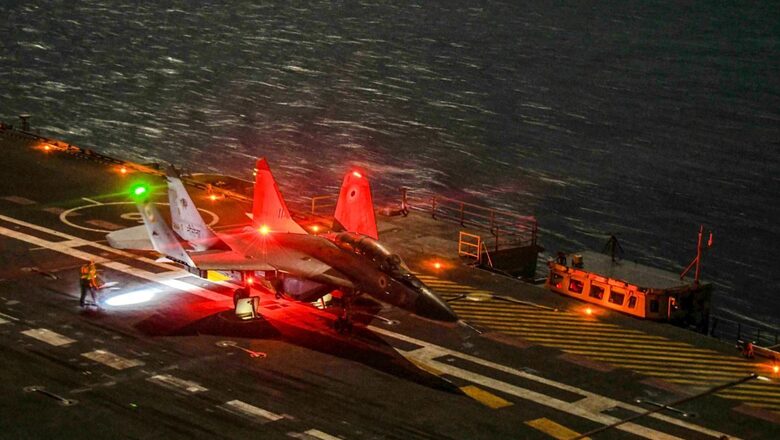
views
France has officially responded to the Indian Navy’s request for 26 marine Rafale fighter jets with a detailed bid, which will be closely evaluated by New Delhi. The navy’s INS Vikrant and INS Vikramaditya are likely to be equipped with these aircraft as India continues its effort to boost its strategic edge in the Indian Ocean Region amid increasing threat from China.
According to a report published by NDTV, India and France will enter contract negotiations over a deal that is expected to be at least 5.5 billion euros (nearly Rs 50,000 crore).
Both the aircraft carriers of the navy already have MiG-29K jets onboard, but these have been plagued with reliability issues as per a 2016 audit report. “The MiG-29K, which is a carrier-borne multi-role aircraft and the mainstay of integral fleet air defence, is riddled with problems… [In] a best case scenario, a MiG-29 jet will be fully fit for operations less than 50 percent of the time it is required to be deployed,” the report had stated.
Hence, the navy is planning to supplement the MiG aircraft with the Rafale jets. In August, navy chief Admiral R Hari Kumar had also stressed that the “state-of-the-art French fighter jets Rafale-M will replace MiG-29s”.
China, meanwhile, is all set to induct its third aircraft carrier. Navy sources told NDTV that there is every possibility of China operating a carrier battle group in the Indian Ocean in the future. This makes it all the more important for India to strengthen its sea arsenal, which is the motive behind the decision to procure the marine Rafale planes.
This is India’s second major acquisition of fighter aircraft from France’s Dassault Aviation in recent years – the first being the purchase of 36 Rafale aircraft for the Indian Air Force.
How are the marine Rafale jets different?
India had submitted a request for 22 single-seater fighter jets and four twin-seater trainers of the marine Rafale jets. The marine Rafale is different from its land-based variant.
Naval fighter jets are built to cater to the demands of operations on aircraft carriers. These challenges include high-impact landings, catapult or ramp launches, and exposure to corrosive saltwater environments.
The Defence Acquisition Council had approved the purchase of marine Rafales shortly before Prime Minister Narendra Modi’s visit to France to attend the Bastille Day parade in July.
What else is there in the navy arsenal?
The Centre has recently signed off on major purchases for submarines, drones and air defence systems over the past few years as part of the military’s modernisation. In July, the Defence Acquisition Council also cleared proposals to buy three additional Scorpene submarines – also from France.
Aircraft
The navy is planning to buy more Poseidon-8I aircraft from the US after a billion-dollar deal in 2016. Seen as “India’s eye in the sky”, it can remain in the air for about 10 hours.
Submarines
India already has six Scorpene-class submarines, also known as Kalvari class, in service. They are diesel-electric submarines designed to act like stealthy predators against enemy submarines and surface ships.
Three more such submarines will strengthen the navy’s underwater capabilities as part of the P75 (I) programme in India. This focuses on the construction of six conventional submarines equipped with advanced air-independent propulsion (AIP) systems for extended underwater operations.
Under this project, India is seeking six more submarines from prospective sellers, including Germany and Spain. They will be built in India and involve a substantial transfer of technology.
Drones
India is also purchasing 31 MQ-9B armed drones from the US, worth $3 billion. Out of these, 15 will be for the navy and eight each for the army as well as the air force. This, too, involves significant technology transfer.
The navy has been using two Predator drones from the US on lease. The purchase of the MQ-9B Predator is expected to revolutionise India’s military surveillance and reconnaissance capabilities. The killer drone’s ‘sky guardian’ variant can stay airborne for up to 40 hours while the ‘sea guardian’ up to 30 hours.
This could well be an advantage as China does not have a high-altitude long-endurance drone in its arsenal as of now. India is also in the process of domestically producing 97 drones to meet the medium-altitude long-endurance range needs.



















Comments
0 comment